Staying power: Sportmax, Paul Smith and Margaret Howell's milestone anniversaries
Fashion has long been defined by upheaval, constant change. Now, as the unsoundness of the industry’s fundamental engine – ring up demand for the new and novel – becomes clear, fresh challenges lie ahead. For lessons in resilience and innovation, we look to three brands that have survived and prospered over the decades and are celebrating their half-century
Casper Kofi - Photography
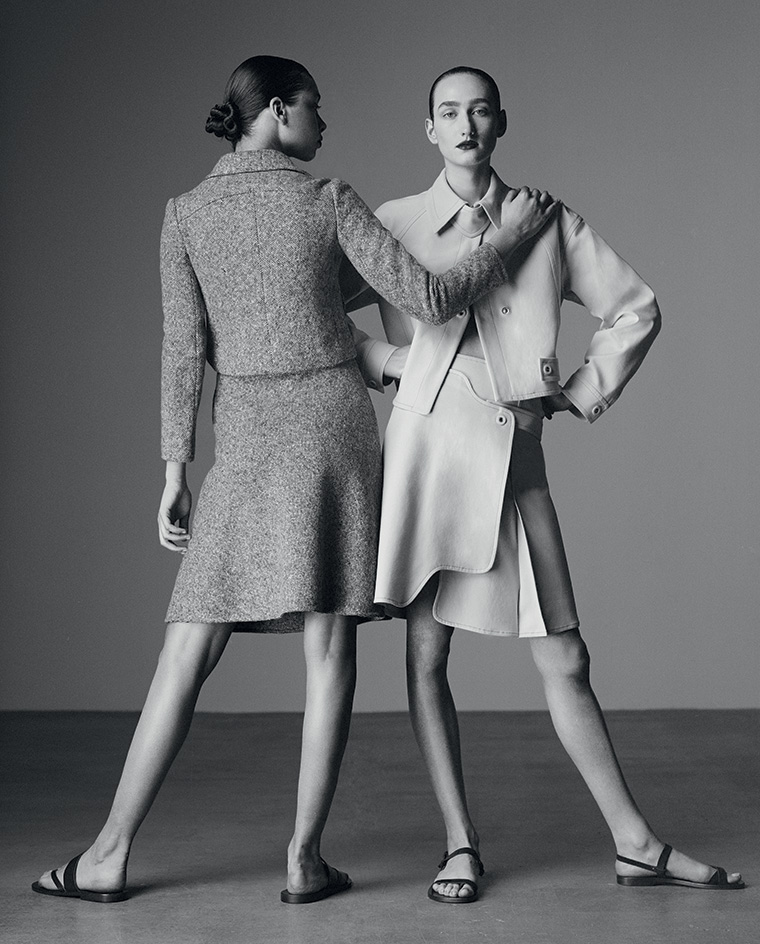
Sportmax

Jacket; skirt, both from the A/W07 collection, by Sportmax
Established in 1969, Sportmax speaks of the vitality and liberation of the 1970s. In uenced by his trips to New York, its Italian founder Achille Maramotti envisioned the brand as the urbane, go-ahead sister of Max Mara, which he had launched from a small factory in Re io Emilia in 1951.
‘The genesis of Sportmax was taking the idea of sportswear and introducing it into daily life,’ says Maria Giulia Prezioso Maramotti, US retail director of the Max Mara fashion group and granddaughter of the founder. Achille Maramotti, alongside Cacharel and Sonia Rykiel in Paris, forged the business of ‘ready-to-wear’. But where his vision really shone was in Sportmax’s focus on style-savvy, fuss-free, mix-and-match separates that could be worn seven days a week.
The collection (first shown as a catwalk presentation in 1976) struck a chord with a generation of women newly entering the workplace. Fifty years on, the team at Sportmax pursues the same ethos, introducing new techniques, hybrid garments and innovative fabrics. Over the decades, the brand (steered by Luigi Maramotti since the 1980s) has employed creative collaborators such as Jean-Charles de Castelbajac and Guy Paulin, but never revealed ‘names’. The anonymity allowed the brand to be the centrepiece.
This spring, a 15-piece anniversary capsule collection that riffs on core styles hits stores. Pieces are finished with Sportmax’s shaded topstitching, creating a signature lightweight feel and deconstructed look. The relevance of Sportmax proves that through the wildest fluctuations in trends and societal shifts, there is poetry to be found in everyday style.
Paul Smith
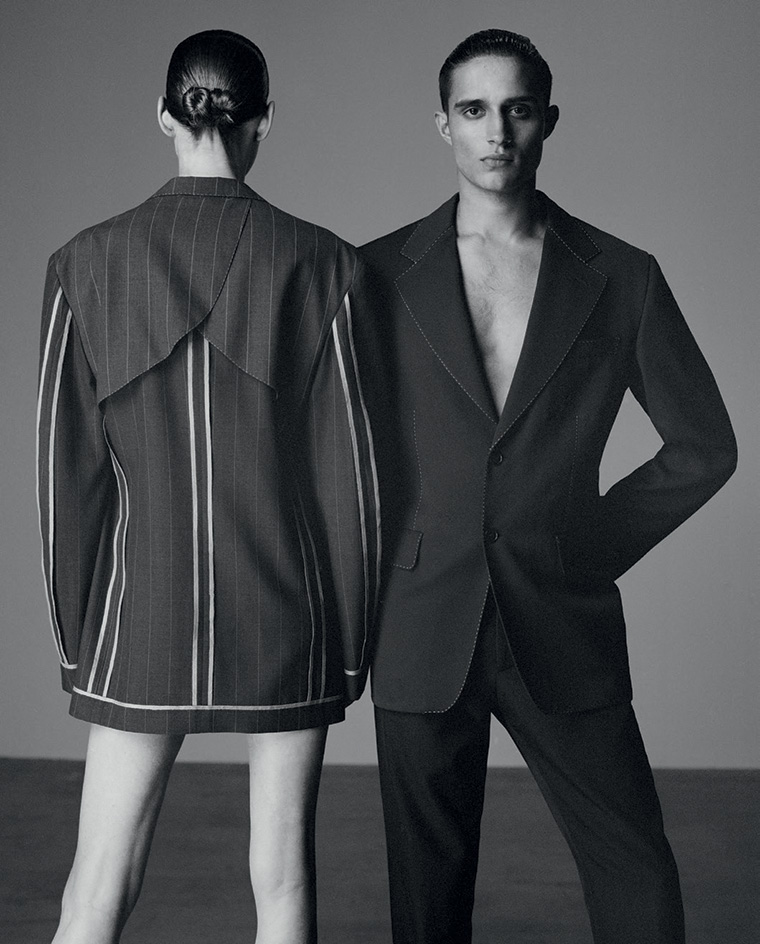
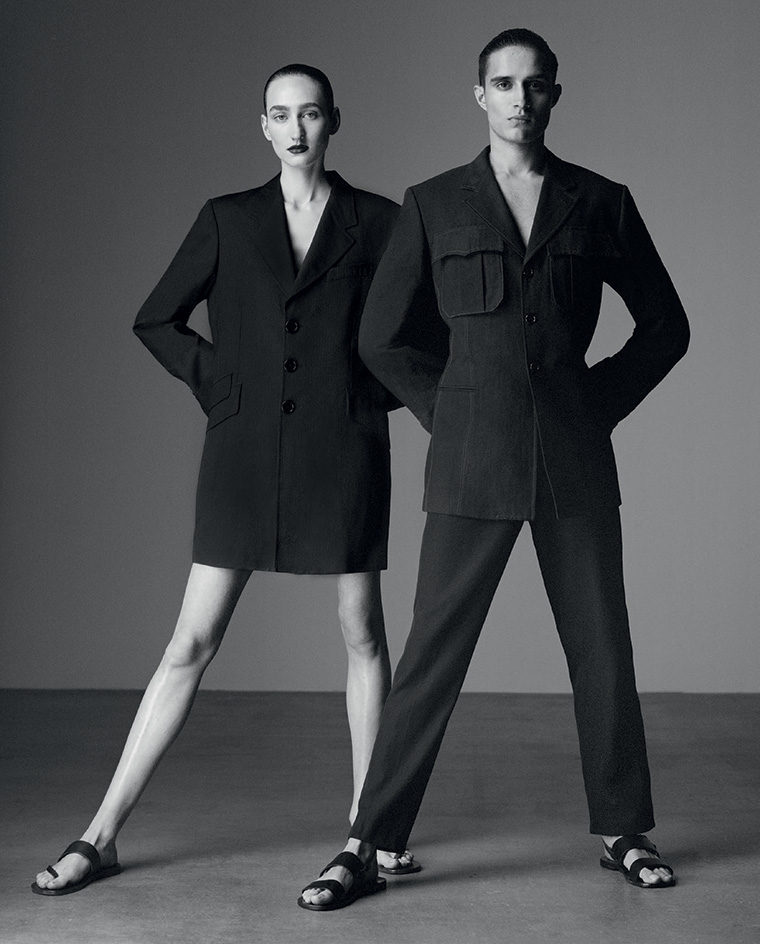
Top, Tamara wears jacket, from the S/S99 men’s collection. Xavier wears jacket, from the S/S98 collection; trousers, from the S/S20 collection, all by Paul Smith. Bottom, Tamara wears jacket, from the S/S94 men’s collection. Xavier wears jacket, from the S/S96 collection; trousers, from the S/S20 collection, all by Paul Smith
Life’s mishaps have a way of opening up new pathways. If it weren’t for a calamitous accident at the age of 18, amateur road cyclist Paul Smith might have pursued his sporting dream. Instead, post-recovery, he found a community of art students at the Bell Inn pub in Nottingham, and learnt the principles of couture from his Royal College of Art-trained girlfriend (now wife) Pauline Denyer.
Opening his first store in Nottingham outshines knighthood as one of his proudest moments. It’s here that Smith, all chiselled good looks and quick wit, learnt how to make customers feel at ease in a con ned space, deploying curios collected from his travels as icebreakers to his burgeoning line of natty suits and shirts. Collecting (dominoes, stamps, cycling memorabilia, ceramics) continues to be a cherished idiosyncrasy. During the design boom of the 1980s, Smith became a national hero known for his ‘classics with a twist’, establishing a network of stores, a vibrant design language and a reputation for comfortable yet smart suits.
Combining the classy and the unexpected – perky, coloured linings, the famous stripes – the brand suggests wit, individuality and that very British quality of self-deprecation. Collaborations with the likes of Leica and Carl Hansen & Søn have boosted Smith’s taste-making clout, while his athlete’s mindset has kept the brand in the fast lane. In an era when overproduction weighs heavily, Smith’s insistence on creating quality products with a difference is an inspiration.
Margaret Howell
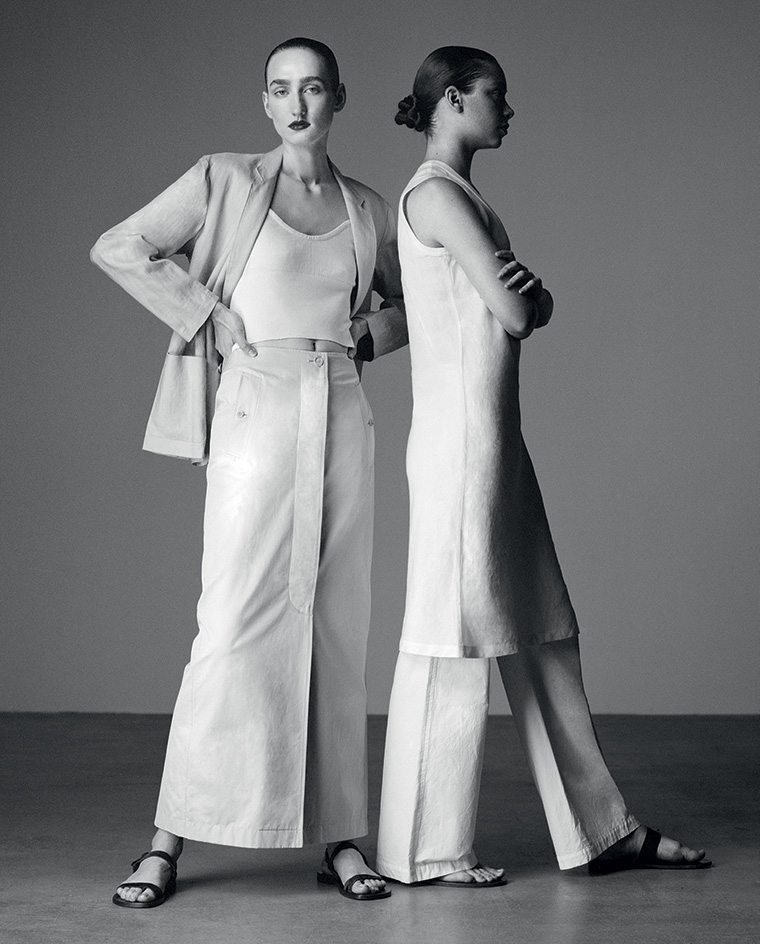
Tamara (left) wears jacket c 1977; skirt, c 1990s. Maria wears dress, c 1990s; trousers, from the S/S04 collection, all by Margaret Howell
‘My work has always been about trying to remain true to myself; it is a consistent style with subtle changes,’ says Margaret Howell of her half-century run. Having graduated in Fine Art from London’s Goldsmiths’ College in 1969, she was rst inspired by a pinstripe shirt found at a jumble sale. She set up a workshop in 1973, and her line of shirts caught the eye of retailer Joseph Ettedgui, who helped her open a menswear store four years later.
At a time when style was dominated ato one end by 1970s amboyance, and at the other by English formality, Howell excelled in meticulously detailed, ‘lived-in’ pieces. ‘I wanted to make items feel contemporary through the proportions, softness and lightness of the fabrics – linen, corduroy, tweed. People responded,’ says Howell. By the 1980s, she was creating men’s and women’s collections and had signed licensing in Japan, a venture that proved a lifeline through the turbulent decade. The brand’s success rests on Howell’s hands-on approach, and what she leaves out (loud colour, extraneous detail) as much as what she includes.
The trend-defying durability of her designs, including an unlined linen shirt jacket dating from the 1970s, and a button- through skirt based on a trench coat, are testament to Howell’s enduring, resilient vision. By introducing photography and 20th- century furniture in her store, Howell also quietly pioneered lifestyle retailing; her stores in London, Paris, Florence and Tokyo remain a lure for collectors and browsers alike.
INFORMATION
sportmax.com
paulsmith.com
margarethowell.co.uk
Receive our daily digest of inspiration, escapism and design stories from around the world direct to your inbox.
-
 ‘I want to bring anxiety to the surface': Shannon Cartier Lucy on her unsettling works
‘I want to bring anxiety to the surface': Shannon Cartier Lucy on her unsettling worksIn an exhibition at Soft Opening, London, Shannon Cartier Lucy revisits childhood memories
-
 What one writer learnt in 2025 through exploring the ‘intimate, familiar’ wardrobes of ten friends
What one writer learnt in 2025 through exploring the ‘intimate, familiar’ wardrobes of ten friendsInspired by artist Sophie Calle, Colleen Kelsey’s ‘Wearing It Out’ sees the writer ask ten friends to tell the stories behind their most precious garments – from a wedding dress ordered on a whim to a pair of Prada Mary Janes
-
 Year in review: 2025’s top ten cars chosen by transport editor Jonathan Bell
Year in review: 2025’s top ten cars chosen by transport editor Jonathan BellWhat were our chosen conveyances in 2025? These ten cars impressed, either through their look and feel, style, sophistication or all-round practicality
-
 Paul Smith’s Claridge’s Christmas tree is a playful slice of ‘countryside in the centre of London’
Paul Smith’s Claridge’s Christmas tree is a playful slice of ‘countryside in the centre of London’Sir Paul Smith is the latest in a long line of fashion designers to curate the iconic Claridge’s Christmas tree. Here, he talks to Wallpaper* about the inspiration behind the tree, which features bird boxes and wooden animals
-
 For A/W 2024, the working uniform gets a futuristic spin
For A/W 2024, the working uniform gets a futuristic spinSculpted silhouettes, unexpected textures and plays on classic outerwear meet in the A/W 2024 collections, providing a twisted new take on city dressing
-
 Pitti Uomo 106: what we learnt from the Florence menswear fair
Pitti Uomo 106: what we learnt from the Florence menswear fairWhile this season’s Pitti Uomo guest designers embraced Florence’s uniquely cinematic setting, at the fair itself, brands presented comprehensive offerings that crossed seasons and celebrated Italian craft
-
 Paul Smith opens up ‘Bar Paul’ for his return to Pitti Uomo after 31 years
Paul Smith opens up ‘Bar Paul’ for his return to Pitti Uomo after 31 yearsPaul Smith’s S/S 2025 menswear collection, shown yesterday evening as part of Florence menswear fair Pitti Uomo, was inspired by the Italian coffee bars of London’s Soho and their artistic patrons
-
 Pre-Fall 2024’s defining looks combine sharp silhouettes with a soft touch
Pre-Fall 2024’s defining looks combine sharp silhouettes with a soft touchA play on texture defines the Pre-Fall 2024 collections, seeing clean lines and pin-sharp tailoring meet soft-to-the-touch fabrics. Here, photographer Mattia Parodi captures the season’s best looks
-
 Mizuno for Margaret Howell is this summer’s most considered sportswear
Mizuno for Margaret Howell is this summer’s most considered sportswearThe latest chapter of Margaret Howell’s collaboration with Japanese sportswear brand Mizuno has been revealed, featuring ultra-lightweight fabrications and sleek, utilitarian design
-
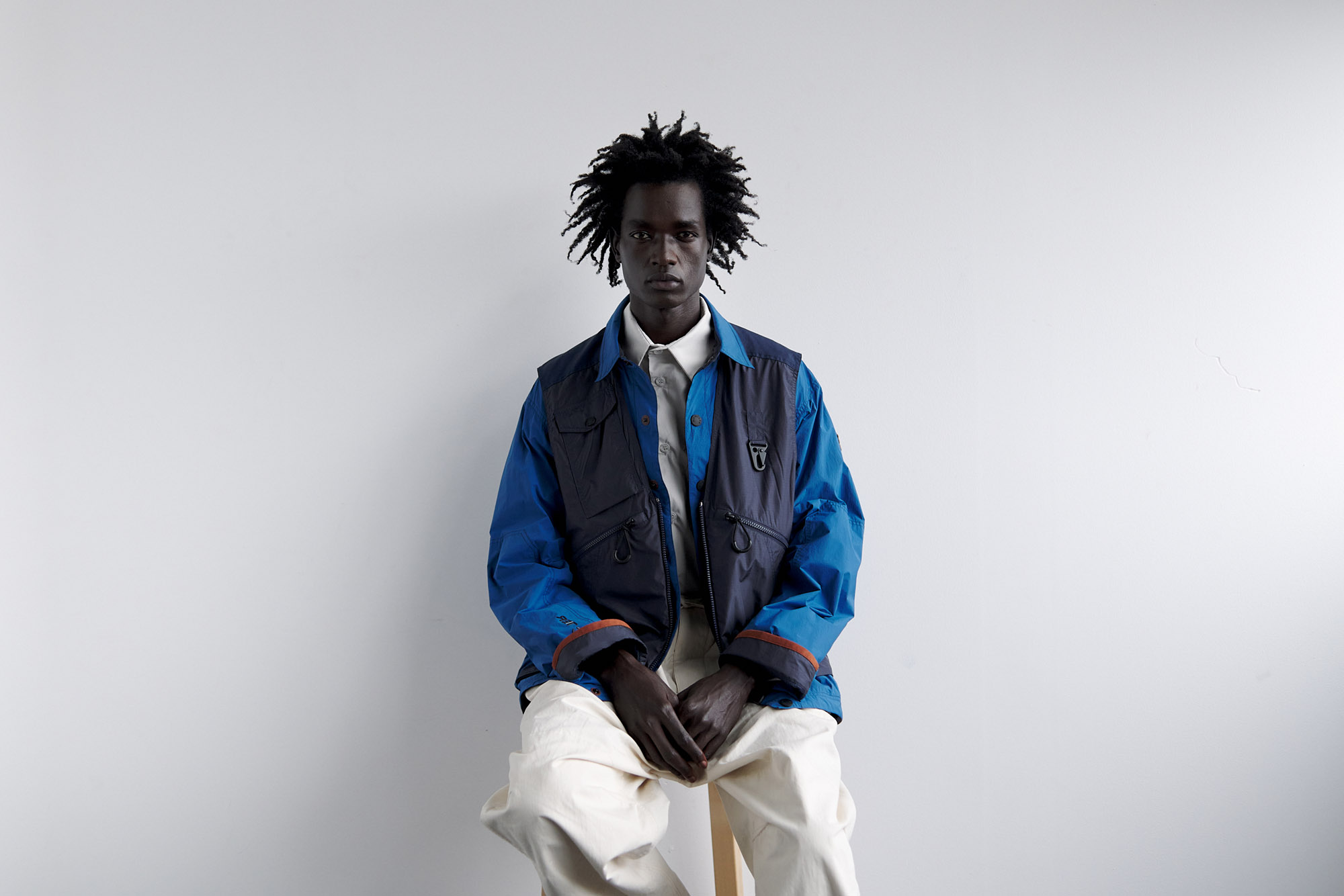 Utilitarian men’s fashion that will elevate your everyday
Utilitarian men’s fashion that will elevate your everydayFrom Prada to Margaret Howell, utilitarian and workwear-inspired men’s fashion gets an upgrade for S/S 2024
-
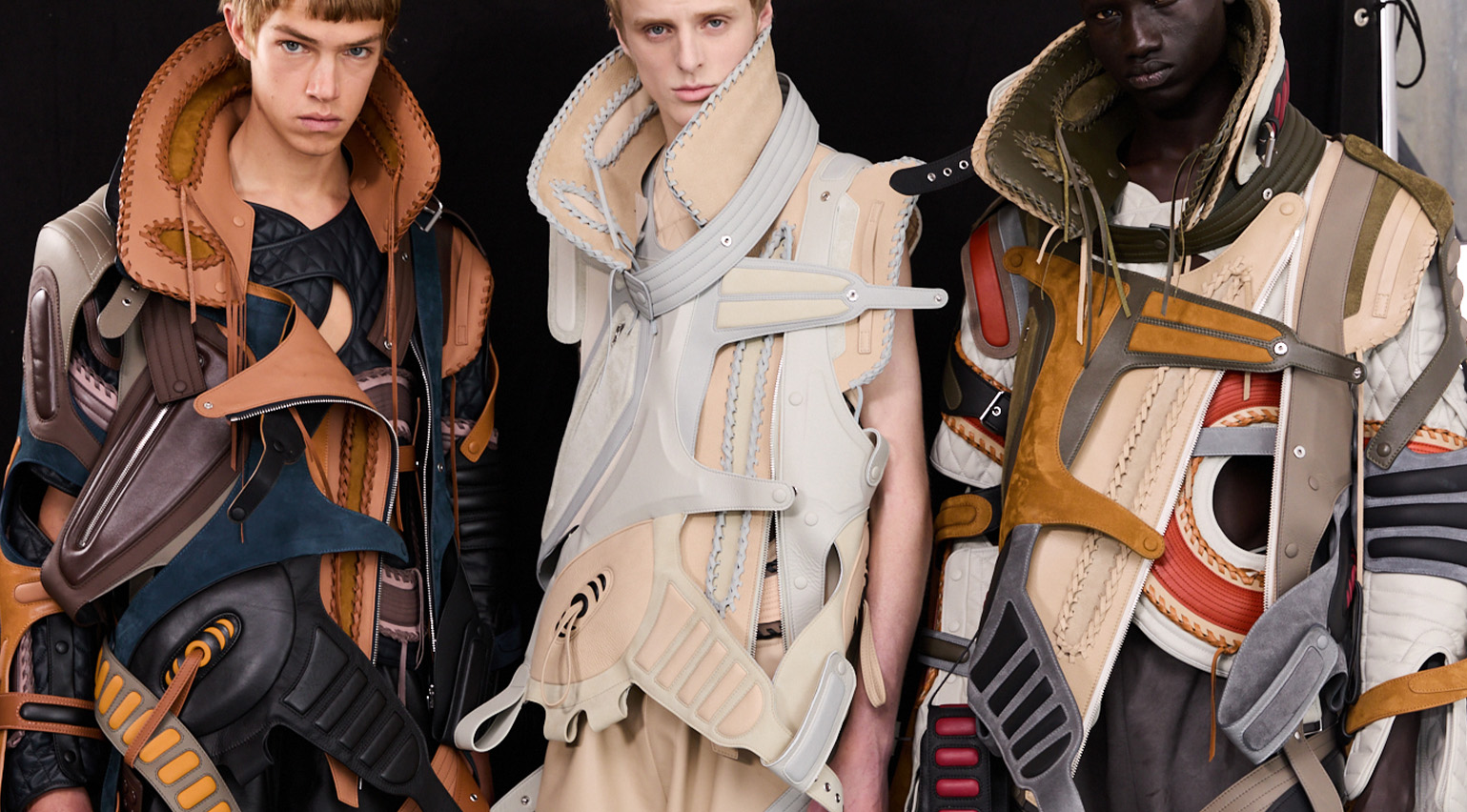 Men’s Fashion Week S/S 2025: what to expect
Men’s Fashion Week S/S 2025: what to expectBeginning this weekend, everything we know about Men‘s Fashion Week S/S 2025 so far, from Dries Van Noten’s final show in Paris to an intimate Craig Green presentation in London